How To Make Lard
This post may contain affiliate links. See my disclosure policy.
A step by step tutorial on how to render fat into lard and the benefits of using it! Learn about the myths surrounding lard and animal fats, the history behind the industry, and how to make lard, store it, and use it!
Use this lard to make the BEST EVER Buttermilk Biscuits and the ultimate Lard Pie Crust!
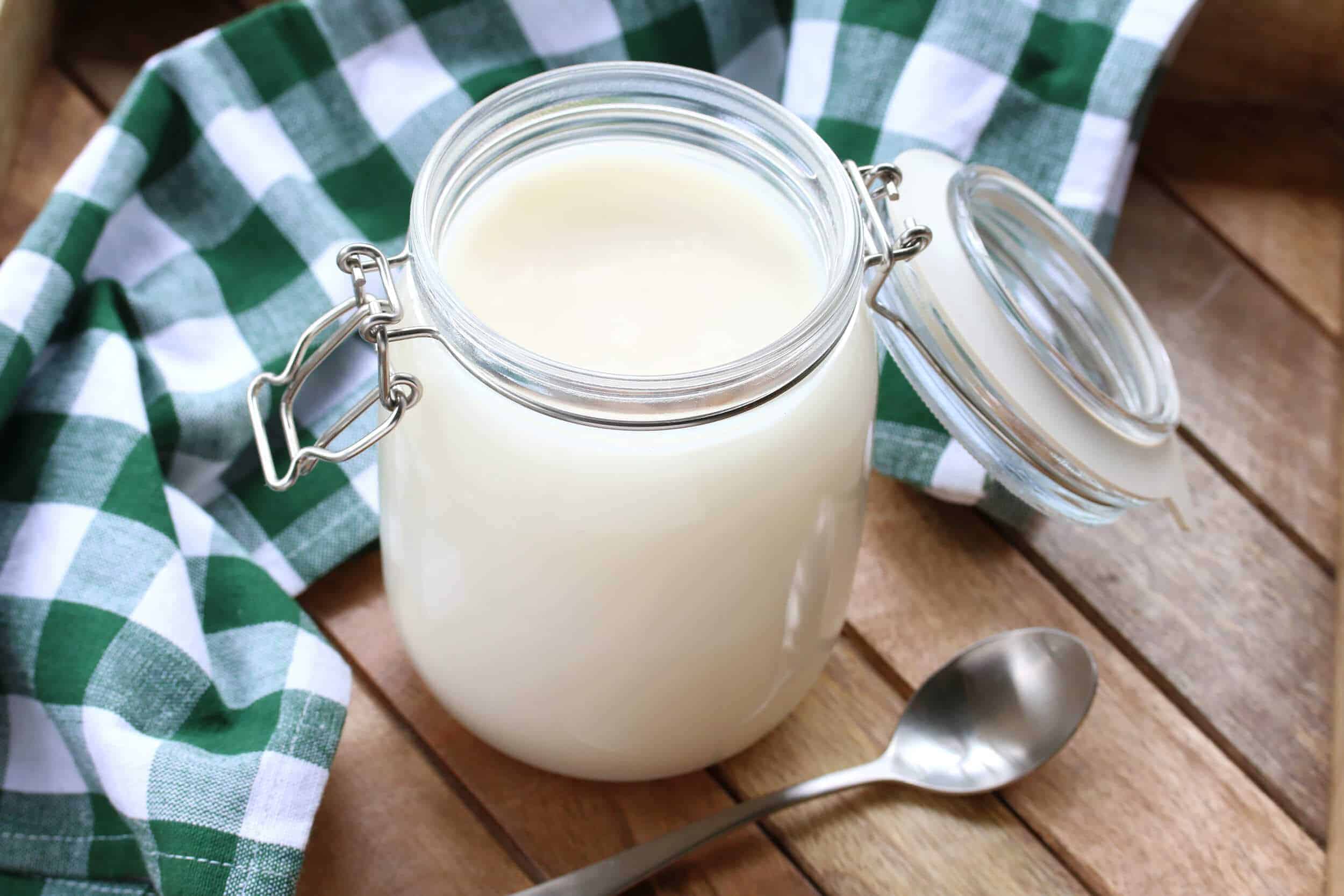
Why We Stopped Using Lard (For All the Wrong Reasons)
Chances are the vast majority of people reading the title and looking at this bottle of lard will have a negative reaction. What will follow is the pronouncement of a string of health conditions that through decades of medical myths have come to be associated with eating lard. In the meantime our ancestors are shaking their heads, “our average lifespan was as long as yours and we didn’t have nearly the number of health conditions as you do today.”
So what happened? What caused us to so vehemently reject one of our ancestors’ most basic food staples?
I won’t attempt to give you all the reasons but I’ll provide a really good starting point. Where: The USA. When: Early 1900’s. Who: Proctor & Gamble.
They had a booming business producing cotton. Which, by the way, is not considered a food crop by the FDA. (That’s important. Keep reading.) But there was this unwanted portion of the cotton plant – cottonseed – that they couldn’t do anything with. And they had lots and lots of it. So they put their heads together to come up with something they could do with cottonseed in order to profit from it. Drumroll…They discovered a method of intense processing that enabled them to extract oil from the cottonseed – and at virtually zero expense to them! But they found the oil was unstable at room temperature and turned easily rancid. Enter Hydrogenation. They figured out that hydrogenating the stuff made it stable and last a long time. And here comes the “What”: The end result was an oil that looked like lard. They called it Crisco.
An issue of Popular Science summed it up this way: “What was garbage in 1860 was fertilizer in 1870, cattle feed in 1880, and table food and many things else in 1890.” And it changed the way we thought about food and the way we ate for generations. The legacy of the anti-lard and butter mindset it established still continues today.
Did you know that more marketing dollars were spent on making Crisco a success than any other marketing endeavor up to that point in history? What ensued from that point on can only be summed up as one of the greatest, most widespread and most misfortunate health scandals of all time with health consequences were are still reaping.
On the one hand, while Crisco was being marketed as cheaper and “healthier” than lard or butter, simultaneously marketing dollars were spent labelling butter and lard as intrinsically “bad.” They even gave away free cookbooks with every purchase of Crisco. And of course you can guess which ingredient replaced everything that normally would have called for butter or lard.
With so much marketing wealth and power behind the effort, it took only a few years to turn an entire nation away from the source of fat that had been used for centuries by their ancestors. And it was successfully labeled as hazardous to our health. Oh, the sad irony.
Decades later, when illnesses began mounting to the point where the statistics could no longer be ignored, the statement was finally released that hydrogenated oils are bad for you. But the fat phobia continued as did the manufacturing of substitute oils.
One such oil: Canola. Guess where canola oil comes from? (Hint: No, it’s not the canola plant. There’s no such thing per se. The “canola” plant was developed in the 1970’s and is nothing more than a modified, cross-bred version of the rapeseed plant.) The name is the shortened version of “Canada oil low acid” and comes from rapeseed. Another non-food crop. Here’s a little history on rapeseed oil: During WWII, rapeseed oil was used on naval ships as a lubricant. When the war ended, there was so much farmland in Canada already dedicated to growing rapeseed that they wanted to find other uses for it so they could continue pulling a profit. The problem with rapeseed oil: It’s such a terribly foul-tasting and rancid-smelling oil that it isn’t fit for human consumption. And so they spent the next few decades until the 1970’s working out a way to make it edible. That process requires heavy refining, bleaching and deodorizing using harsh chemicals (as far from “natural” as it gets) to finally yield the neutral-tasting, odorless oil that now sits on grocery store shelves bearing the American Heart Association’s seal of approval.
Fast forward to today: Almost all processed and pre-packaged foods – everything from chips and breakfast cereal to canned soups and salad dressings – are made with either canola, cottonseed, soybean/vegetable or corn oil. Why? Because they’re cheap to produce. And because we’re still in this mindset that they’re somehow better for you than lard or butter. (For more info on why soybean/vegetable and corn oil (and several others) are so bad for you, see this article for an explanation).
Well, we’ve come full circle. Medical research over the past several years has continued to confirm that fat is not the devil it’s been made out to be and that it is not the root cause of cardiovascular disease. Medical literature is finally starting to reflect this as are many health professionals in their medical advice. However, the notion that fat is bad has been so deeply engrained in our culture and medical philosophy for so long that it’s going to take some time before we’ve all caught up to the facts. Even many health professionals are still stuck in that archaic mindset, though we’re slowly starting to see the rhetoric change.
Our ancestors had it right after all.
My philosophy and approach to diet is a simple one and echoes centuries of wisdom: 1) Eat real, whole foods as close to their natural state as possible and 2) eat things in moderation.
So that brings us back to lard. It’s a fully natural, whole food. It can be made in your own kitchen without any special equipment and the process couldn’t be simpler: Melt it. Strain it. Use it. And I’ll show you all the steps you need to make your own lard.
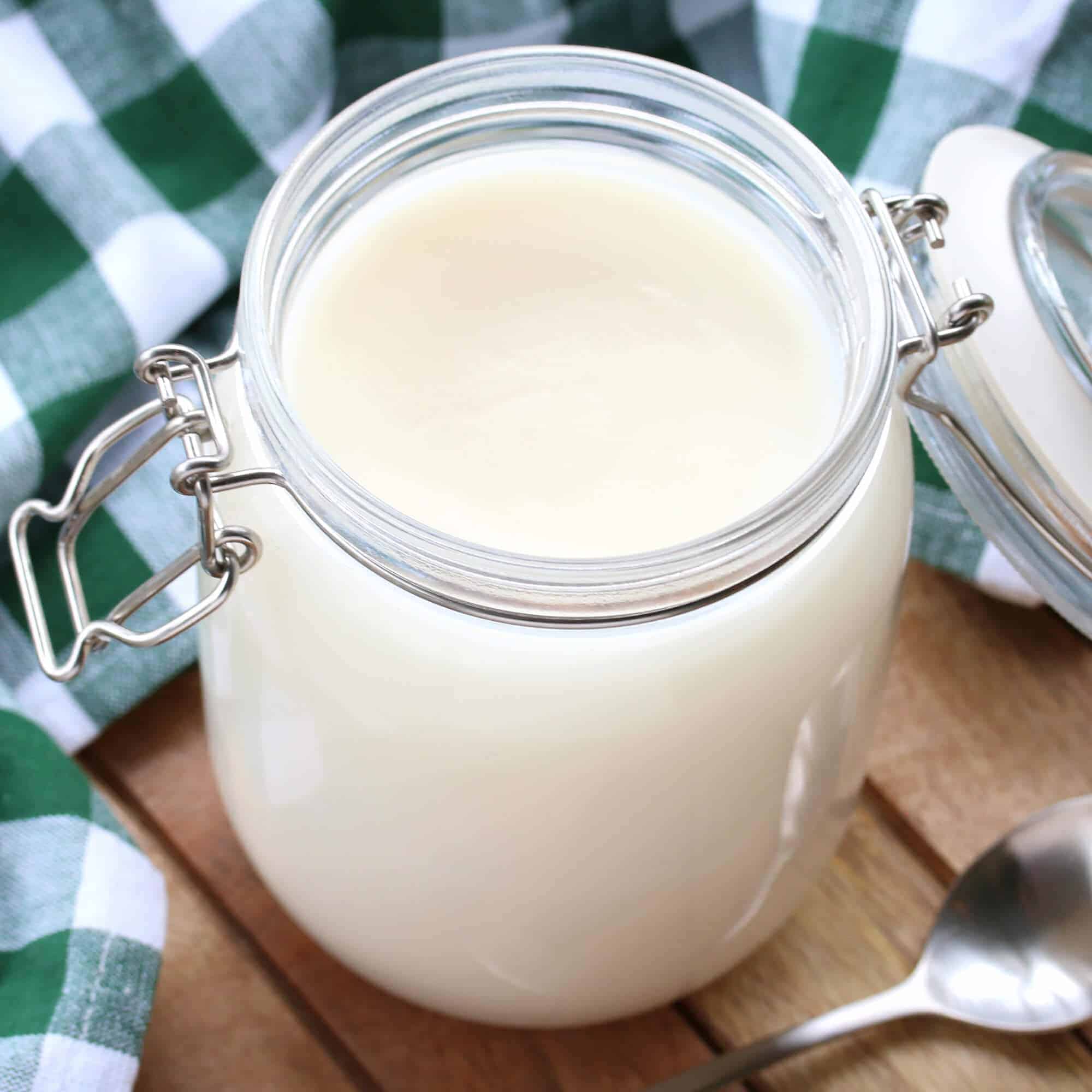
Benefits of Lard
Lard has several advantages over other oils/fats, one of them being that it, along with beef tallow, has one of the highest smoke points. That means it doesn’t oxidize when you heat it (oxidization = cancer). So lard is ideal for high heat cooking (i.e., anything above a light sauté).
Lard also has a high melting point making it the best choice for extra flaky pie crusts and pastries (beef tallow even more so – we’ll be addressing tallow next time.) Get ready to really experience the old-fashioned taste of yesteryear and what made grandma’s baking so famous.
Lastly, it tastes awesome! Get ready to make the best fried chicken, crispy hash browns and just about anything you want to taste just that much better.
Finally, it has health benefits. That’s right, lard is a good thing. To read about its health benefits along with several other reasons to use lard, check out this article: Top 10 Reasons To Bring Lard Back.
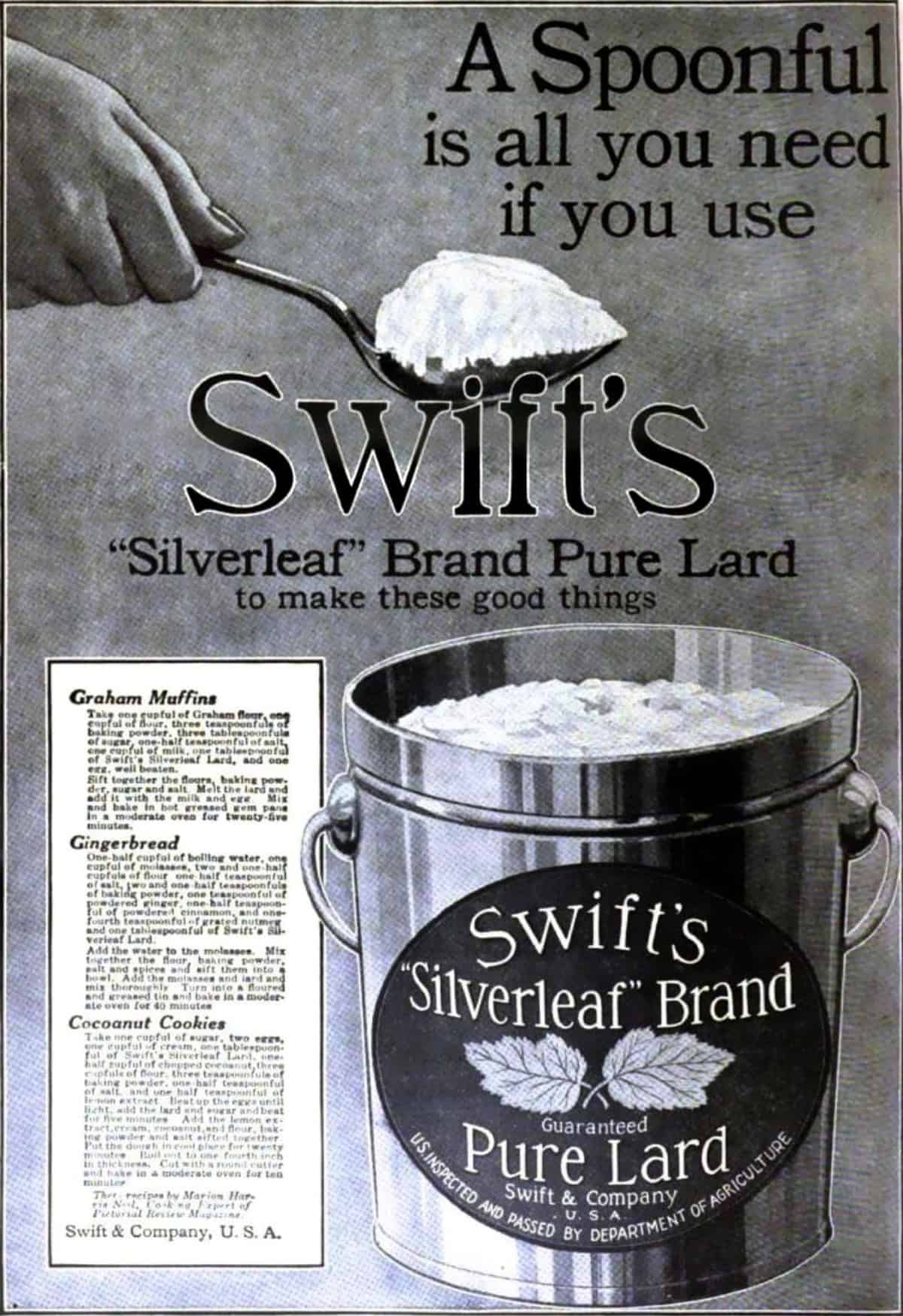
Types of Fat from a Pig
Belly Fat: This is what’s used in the U.S. to make bacon (in the UK it’s known as streaky bacon). As its name suggests, it comes from the belly of the pig and has layers of fat and meat. Pork belly has become popular in recent years in a variety of cuisine. You typically wouldn’t render the belly into lard because there is too much meat attached.
Fatback: This comes from the back of the pig, includes the shoulder and rump areas, and is the thick layer of fat directly underneath the skin. Once rendered it produces a lard that’s slightly yellow in color and it has a stronger pork odor and flavor than leaf fat (see below). It’s great for frying or sauteing. Fatback is also what’s used in sausage-making.
Leaf Fat: This is the fat from around the pig’s kidney’s and, like beef leaf fat, is the “cleanest” fat on the pig. It’s also the healthiest. Once rendered it produces a lard that’s white in color with a milder odor and flavor, making it ideal for use in pie crusts and pastries.
**NOTE: The health benefits of lard apply only to pasture-raised pork. Fat is where a lot of the bad stuff is stored and concentrated (ie, chemicals, additives, by-products of junk ingredients, etc) and for that reason we strongly recommend only using fat from pasture-raised pigs. Avoid fat from commercially raised pigs.
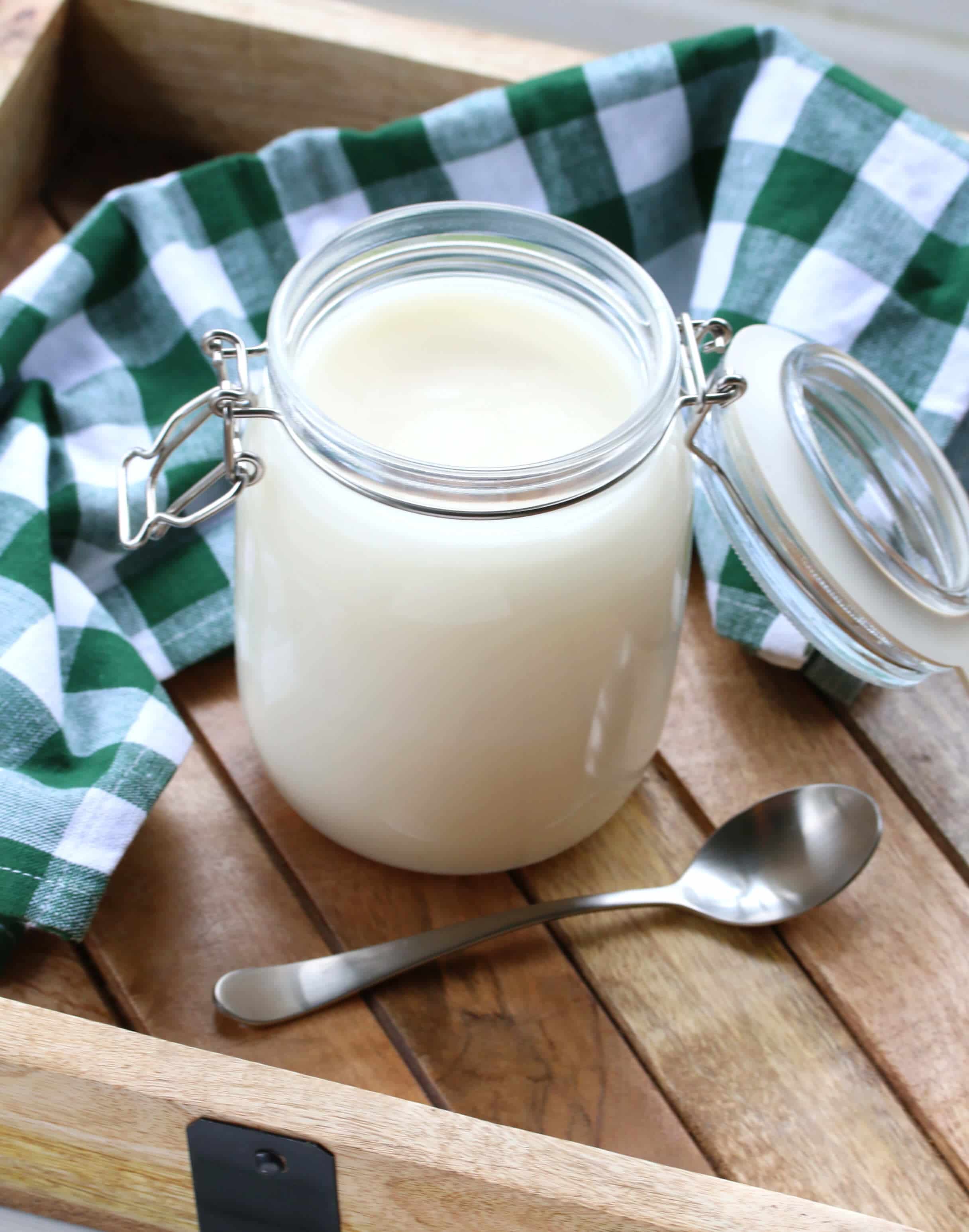
How to Store Lard
Lard was used and stored for centuries before refrigeration was invented. It will keep at room temperature for a long time (traditionally many kept it for up to a year). Nevertheless, today most recommend storing it in the fridge. It’s your call. In the fridge it will keep for at least 6 months and up to a year also and many say it’s less likely to get rancid in the fridge. I’ve heard of many people keeping it for even longer than a year in the fridge. Lard can be kept almost indefinitely and what determines if it’s still good is its smell: If it starts smelling rancid, throw it out and make another batch.
For longer storage lard can also be frozen. Freeze it in bars, in cubes, in tablespoon amounts, in tubs (slicing off what you need, no need to thaw), whatever you prefer. Lard can also be frozen in glass jars once the fat has solidified at room temperature.
It is best to only freeze it once though, not thaw and re-freeze.
Shelf Stability
Homemade rendered lard is very shelf stable. The process of rendering it removes excess water and other impurities, thus preserving the fat and keeping it from spoiling.
Is Lard Pasteurized?
Because lard is a pure fat and does not contain enough water to support bacterial growth (i.e., causing spoilage) lard doesn’t need to be pasteurized.
A word of Caution
If you choose to buy lard rather than render it yourself, be very careful about the lard you find in stores. Many of them are hydrogenated and many also contain large amounts of highly toxic benzene derivatives known as BHA and BHT. Avoid these. Plus, making it yourself is MUCH cheaper than buying it. Most “clean” commercial lard on the market charge more than $20 per pound. I’m able to make more than six times that amount for the same price!
If you have a local butcher you trust that makes lard from pasture-raised pigs, perfect. Otherwise I strongly recommend making it yourself, choosing fat pastured pigs that were raised responsibly. As noted earlier, fat is where a lot of the bad stuff is stored and concentrated (ie, chemicals, additives, by-products of junk ingredients, etc) and so it’s important to choose “clean” fat from pigs that were pasture-raised and avoid fat from commercially-raised pigs.
Three Ways to Render Fat
You can render lard in a heavy pot in the oven between 225-250 degrees F, on the stove top over low heat (start at “2” and once it begins melting turn it down to “1”) or in a slow cooker on LOW. Whichever method you choose, just remember that if you’re wanting a neutral flavor for using in pastries and pie crusts, cook it over very low heat, otherwise your lard will have a much stronger, “piggy” flavor (which is still fine for things like frying and sauteing where you want to add a little flavor boost).
Troubleshooting
Help, my lard has grown mold! Pure fat doesn’t grow mold, it goes rancid. So if there’s mold on it it’s because it wasn’t rendered long enough and/or it wasn’t strained properly. If there are any bits of meat or sediment left in the lard after rendering it, those will grow mold.
I’ve also heard some people recommend that if you’re going to store the lard in the fridge instead of at room temperature or freezing it, to cover it with cheesecloth or a tea towel and rubber band since a screwed on lid can trap moisture inside the jar.
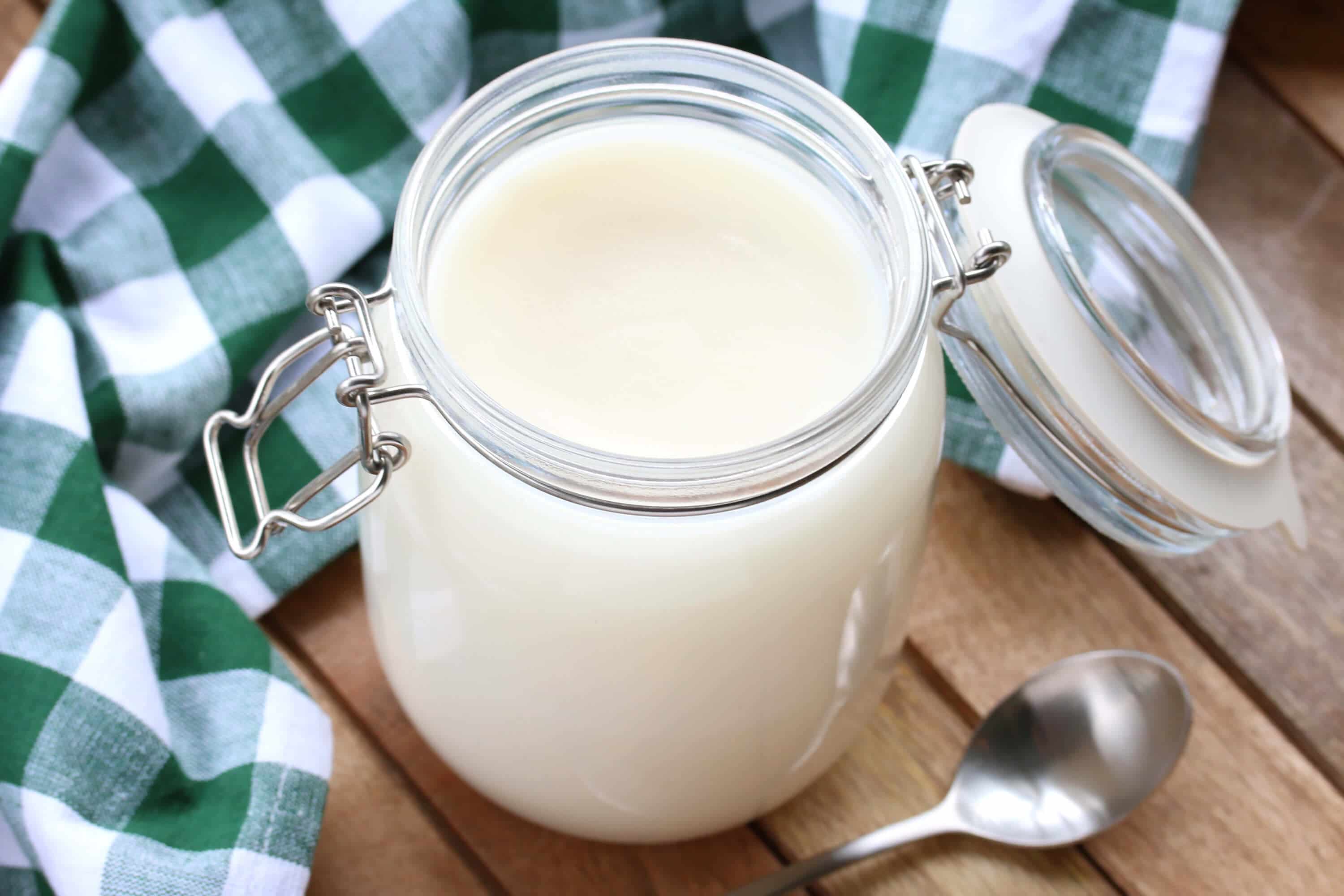
How to Make Lard
Let’s get started!
I’m using leaf fat for this. Referring to the section above about different kinds of fat.
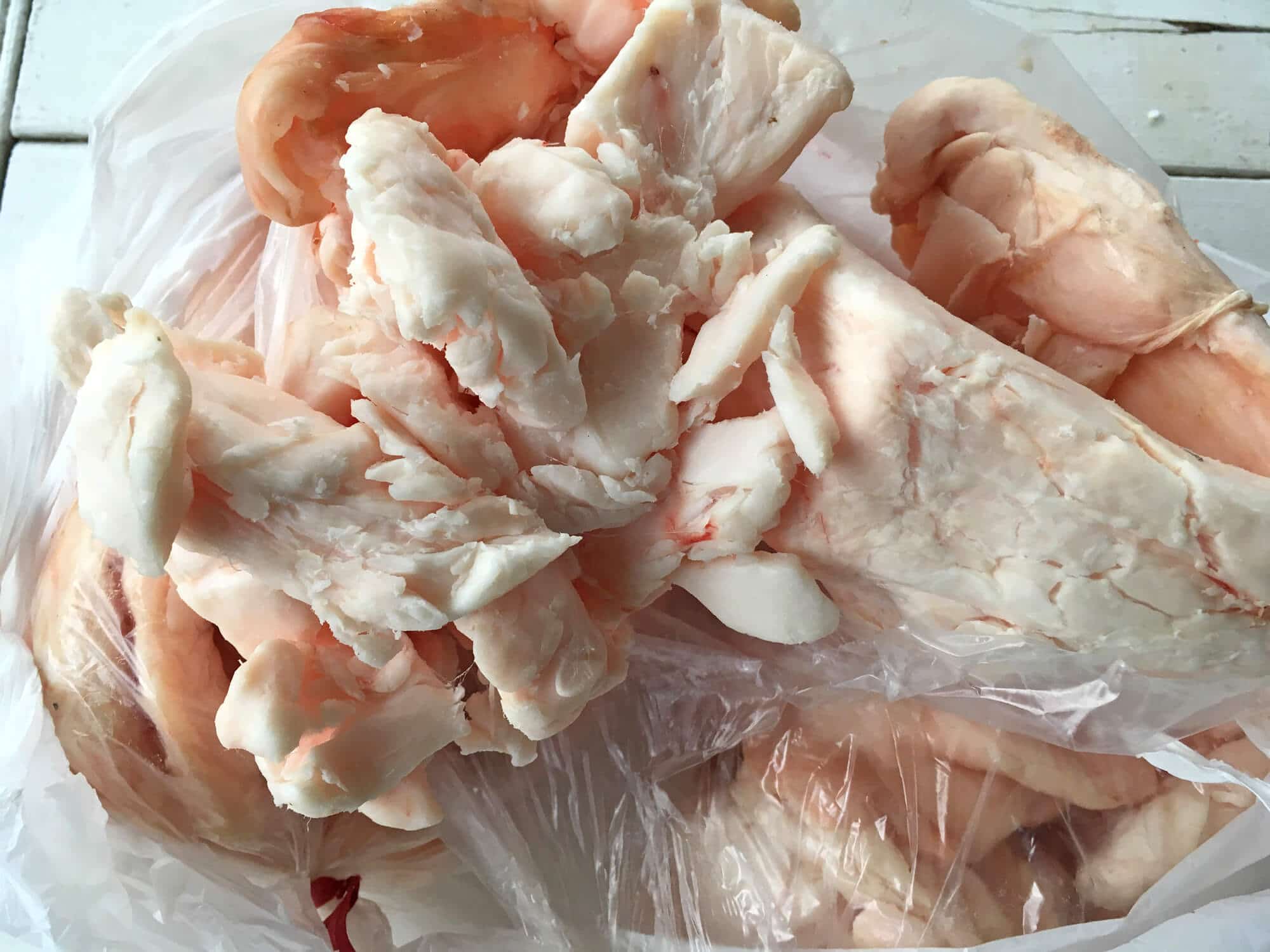
I highly recommend freezing the fat first because it makes the job of chopping the fat MUCH easier and cleaner!
Dice the fat as small as you can. The smaller you chop the pieces the quicker it will render and the more lard you will get out of it. (Note: I recommend chopping it smaller than the batch pictured below. That was my third batch that week and I was getting impatient.) **Also, if you have a friendly butcher who is willing to grind the lard for you, ask them. Alternatively you can freeze it and finely chop it in your food processor.
Place the fat in a slow cooker and set it to LOW.
If you’re melting it over the stovetop, place it in a heavy pot and set it to “2”. Once it begins melting set it to “1”. (Again, the key is cooking it over low heat to produce a beautifully clean and white lard with a neutral flavor.)
You can also render lard in the oven: Place it in a heavy pot (Dutch oven is perfect) and set the oven between 225-250 degrees F.
I leave the lid off to prevent water/moisture from building up, which can lead to spoiling. By leaving the lid off, any developing water/moisture will evaporate.
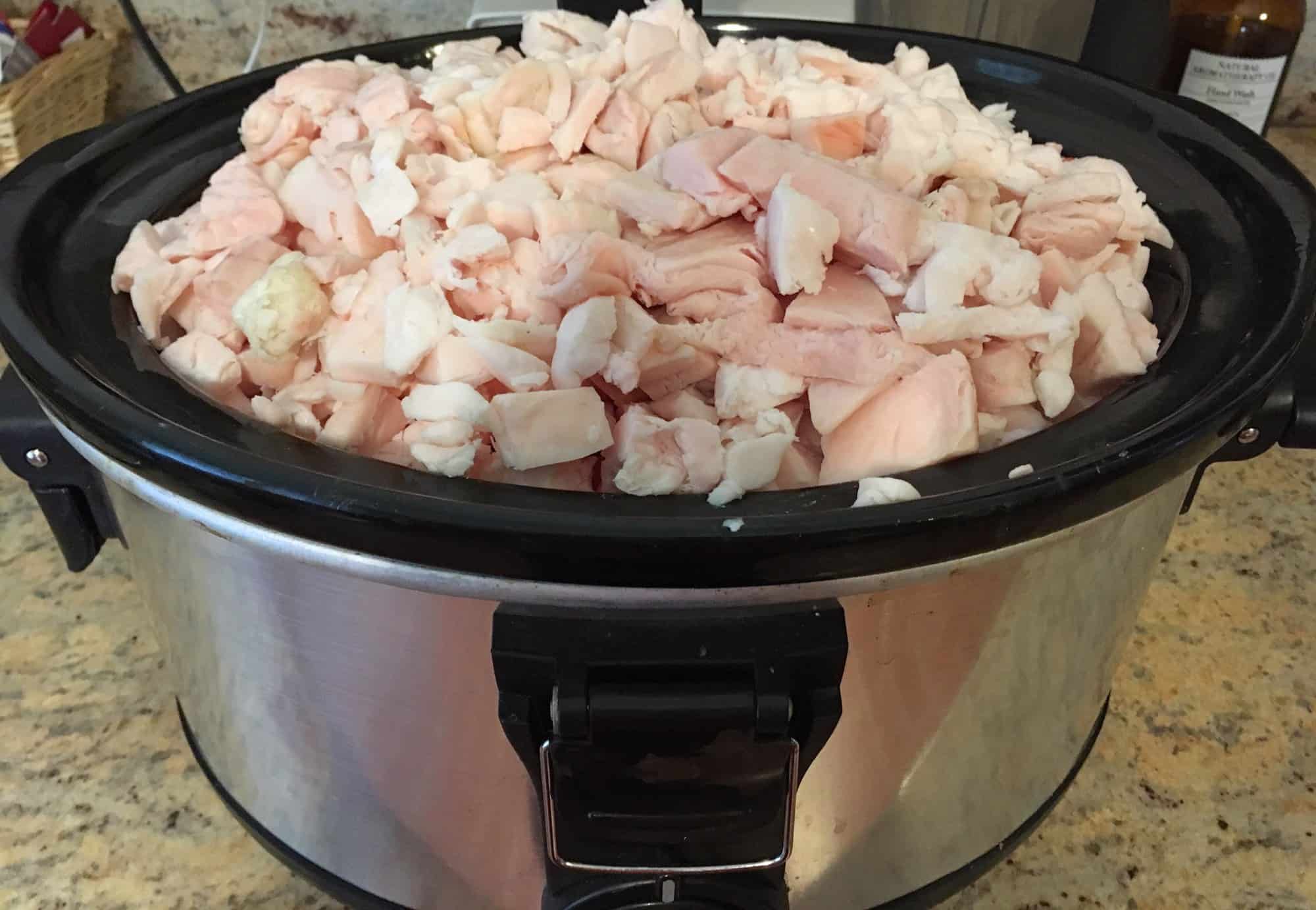
It will take several hours. The cracklings will soon sink down and then rise up again. Once they’ve risen again the lard is done. Another indicator that it’s done is that it will audibly crackle, gasp, and sigh!
If you over-cook it or allow it to burn on the edges, the lard will begin to brown and you’ll end up with a lard that has a stronger porky flavor. It’s still completely usable for things like frying and sauteing, it’s just not ideal for making sweet pastries and pie crusts.
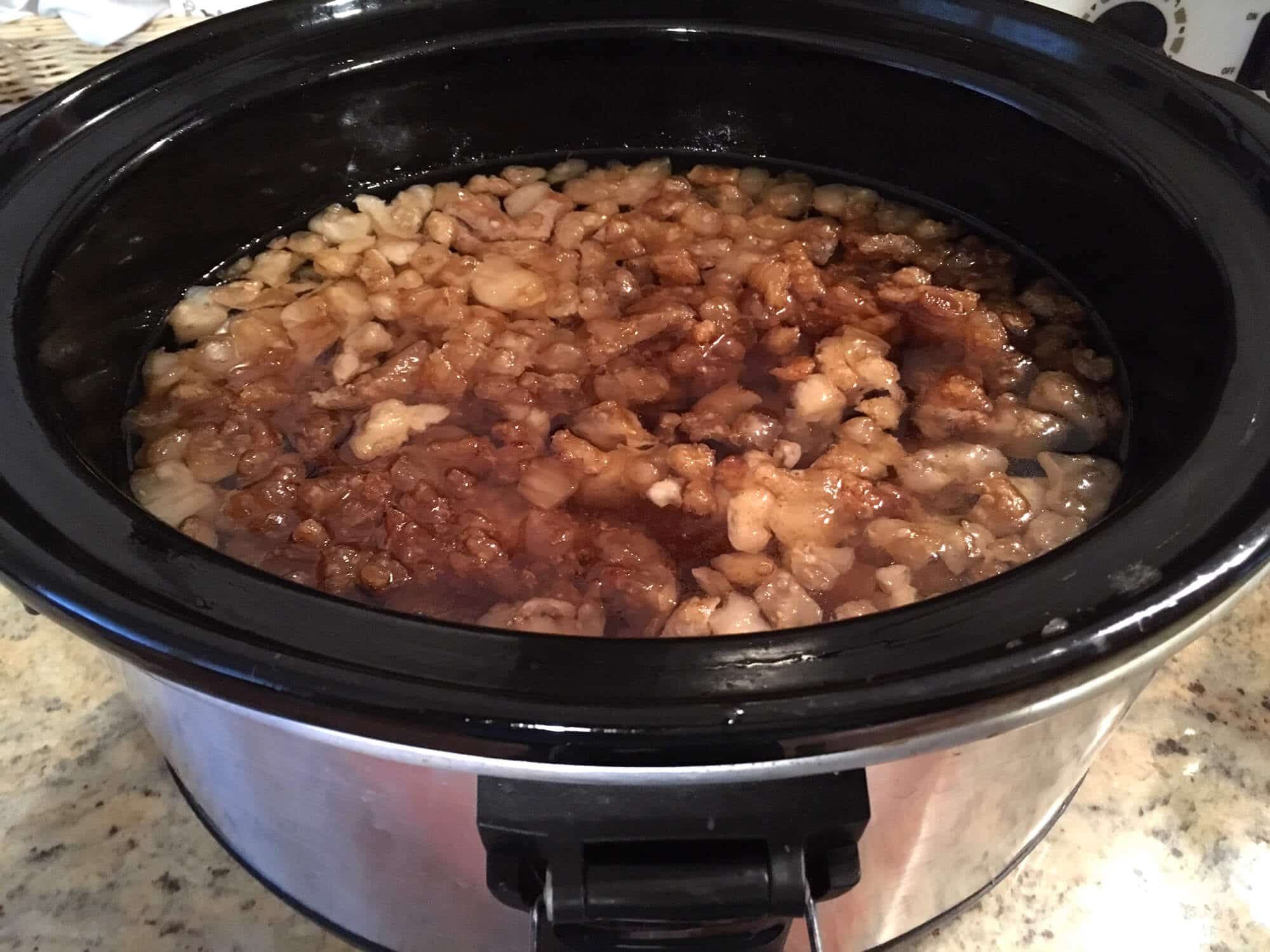
What to do with those sad, limp bits of pork fat? Turn them into crispy cracklings! Transfer them to a frying pan and fry until they’re puffy and crispy. If you want, add some seasonings. Eat them as a snack or sprinkle them over your salads.
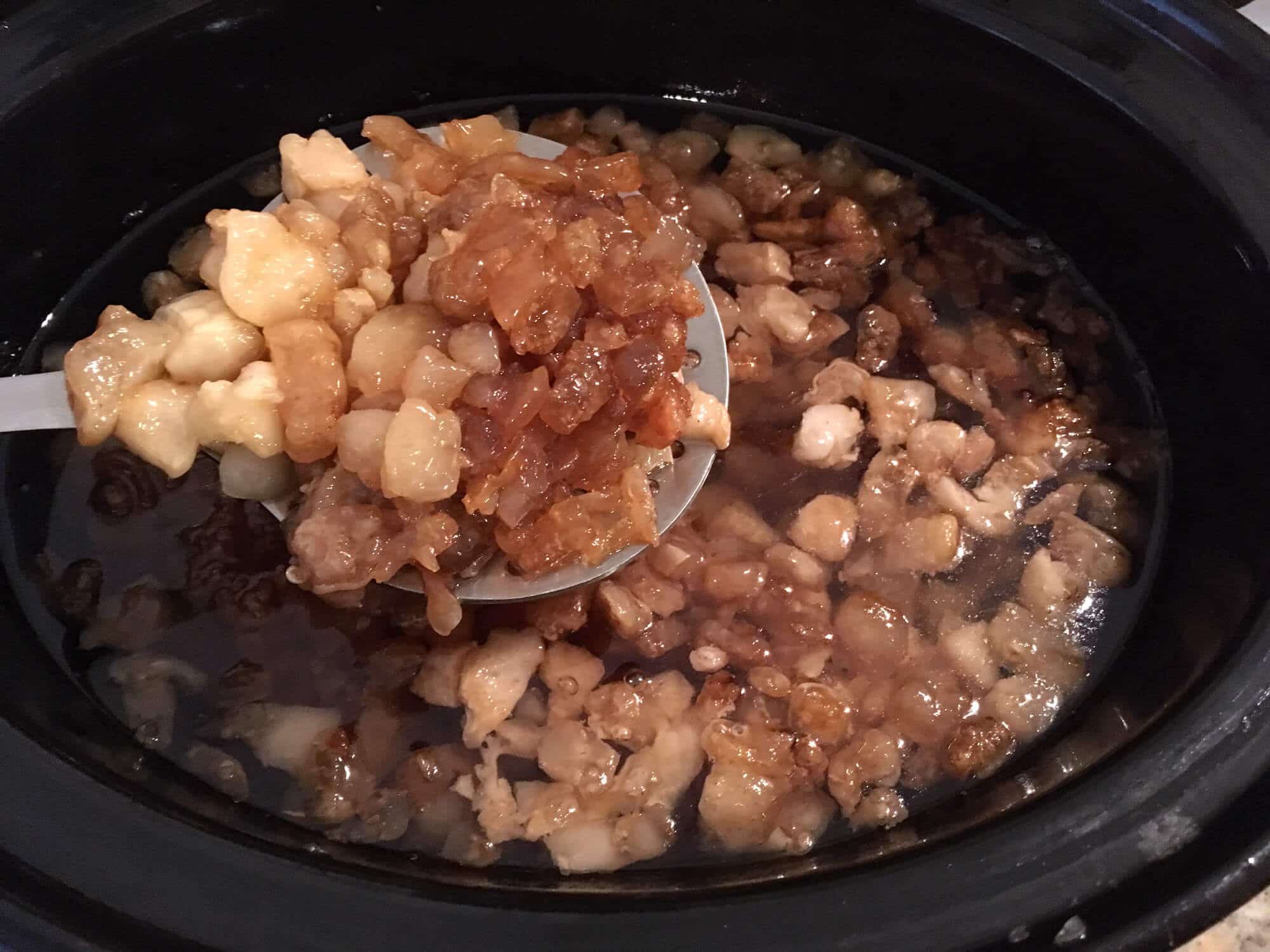
Strain it through a fine mesh colander to remove the cracklings. Then strain it again through 3 layers of cheesecloth to remove the remaining small bits and sediment.
It’s critical that you remove any bits of fat and gristle along with any tiny bits of sediment, otherwise your lard will get moldy. Pure fat doesn’t grow mold, it goes rancid. So if there’s mold on it it’s because it wasn’t rendered long enough to remove all the water and/or it wasn’t strained properly. So be sure to properly strain it.
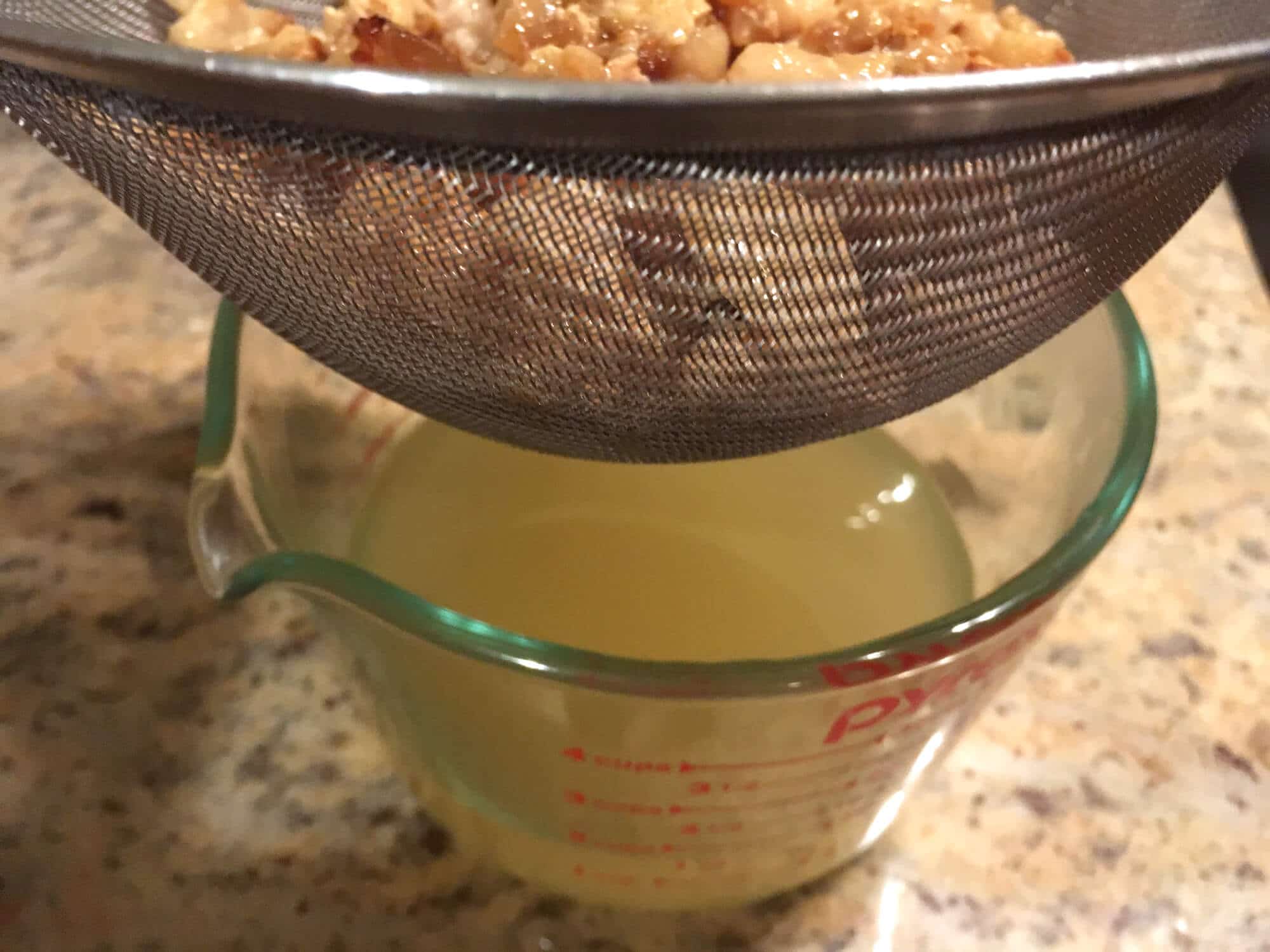
In its liquid state, the color of the lard will be like lemonade or apple juice. Once it cools and hardens it will become white.
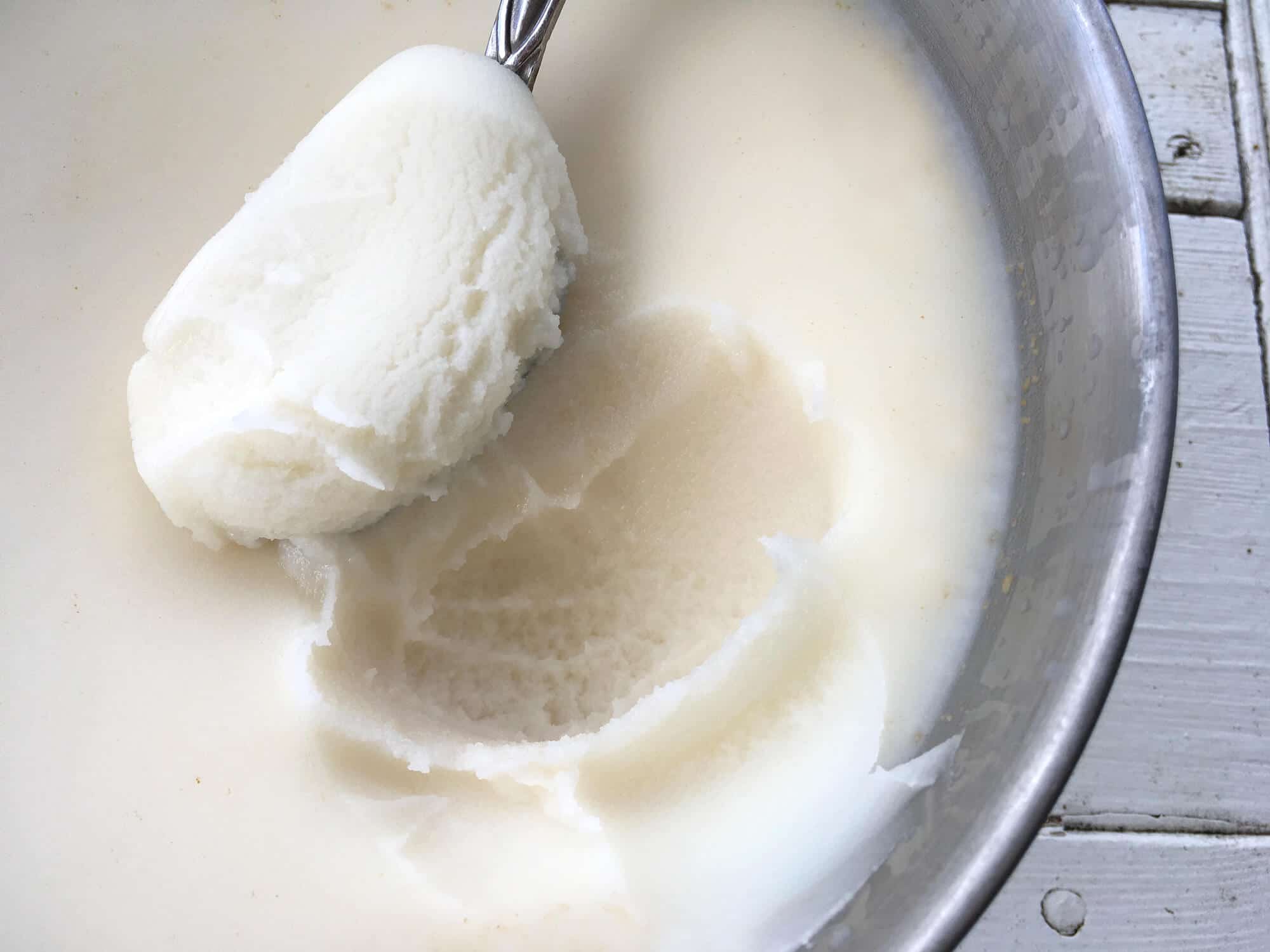
Place the melted lard in whatever container you want to keep it in long-term (preferably glass or, if that’s not available a non-reactive metal). Let it sit undisturbed at room temperature until it has to cooled down and is firm (it firms up pretty quickly).
For information on how to store lard, see the “How to Store Lard” section above.
Enjoy!
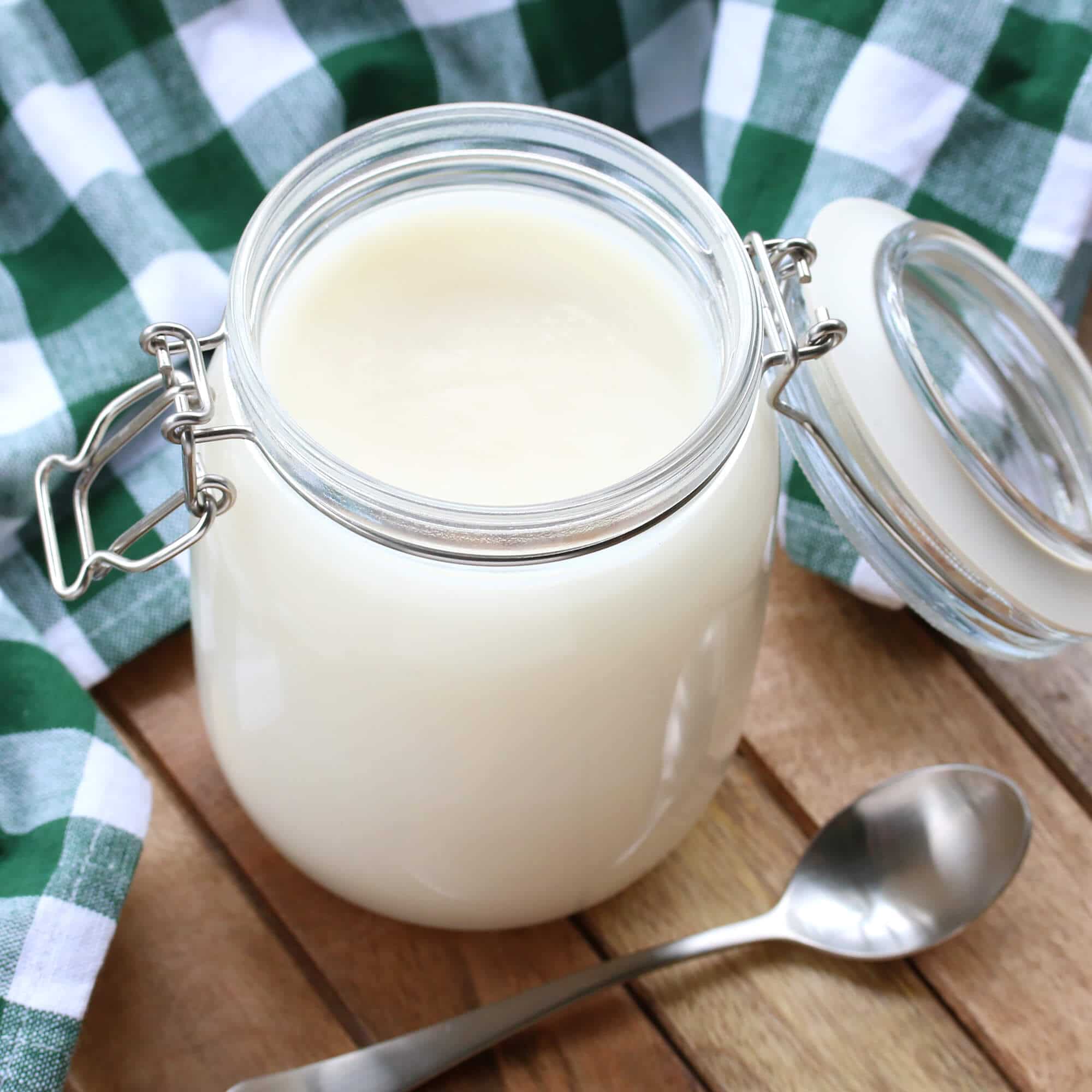
Be sure to also check out our tutorials on:
Save This Recipe
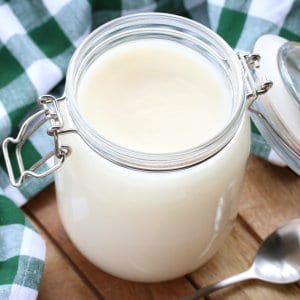
How To Make Lard
Ingredients
- 2 pounds leaf lard or fatback (depending on what you're using it forl; see blog post for description), diced as finely as you can (it's easiest to dice while frozen)
- NOTE: You can use this same method for beef tallow and other animal fats
Instructions
- This can be made in the slow cooker, in the oven, or on the stovetop. For the oven and stovetop method see the blog post tutorial above. Slow Cooker Method: Place the diced fat in the slow cooker and set it to LOW. Leave the lid off while to prevent moisture buildup which can lead to spoiling. It will generally take at least 3 hours, often more, for the fat to render, especially if you're making a larger batch or if the chunks are large. The pieces of fat will sink down to the bottom and then rise up again after a few hours, indicating that the they are done rendering. Be careful not to over-cook the lard or allow the edges to burn or you'll end up with lard that has a stronger pork flavor (though still usable for frying savory things, just not ideal for sweet pastries and pie crusts). Strain the rendered lard through a fine mesh colander and discard the chunks (these can be fried to create crispy flavorful pork cracklings). Strain the lard a second time, this time time through 3 layers of cheesecloth to remove any small bits and sediment which cause spoilage. In its liquid state, the color of the lard will be like lemonade or apple juice. Once it cools and hardens it will become white.Place the melted lard in whatever container you want to keep it in long-term (preferably in a glass jar). Let it sit undisturbed at room temperature until it has to cooled down and is firm.Store your lard in a cool, dark place. It will keep longer in the fridge if you have the space and you can also freeze it. 2 pounds of pork fat will yield roughly 1 to 1 1/2 cups of lard.
Originally published on The Daring Gourmet May 15, 2017



















I grew up as the daughter of farmers. Dad raised hogs and cattle, corn and soybeans, Mom raised chickens and had an egg route in town.
When we butchered a hog, my mom rendered the lard. I grew up not knowing anything different than lard. I am a young 72 years, normal cholestral. We had bacon, sausage or ham most every morning for breakfast. My dad’s cholestral was normal til the day he died.
Mom did the rendering outside in a big cauldron. I didn’t pay much attention because I was stirring and waiting for the cracklings.
I am so happy to read this article. I thought the only way to get it was on the shelf at the grocery store (I am going to throw out the carton I have now)!
When I learned to ask for leaf lard, I went immediately to our local meat market who happened to have it on hand. I am excited to render.
Thanks so much for sharing, Margaret. I’m happy you were able to find leaf lard and am excited for you! Happy rendering! :)
Just made my first batch. Thank you! Your instructions were so simple to follow.
Hi there,
Is it only recommended to use a dutch oven or heavy metal pan if the fat will go in the oven? I only have a roast pan, will that be too light?
Hi Heather, no it’s for stovetop. You can use your roast pan, just be sure to keep the temperature low.
I can’t seem to make a new comment, so I’m replying here. Thank you for this post! Very excited to render Ltd and can’t wait for the post on tallow!
What kind of beef fat should I use and where can I find it? Would Wegman’s or Whole Foods have it? Thanks!
Hi Elizabeth, it depends on what you’re using it for (baking vs. cooking). In my blog post I discuss the different kinds of fat and what they’re used for. The best place to source it is from a local butcher. Not the meat department of a grocery store but an actual independent butcher.
Could you tell me how many pounds of fat you did in the crock pot? I just found a source of pastured fat that I’ll get in a couple of weeks. I ordered 40lbs and am trying to prepare ahead of time.
Also, the best way to grind the fat if the butcher doesn’t do it? Food processor? Blendtec?
Thank you for the great article!
Hi Brenda, I use different amounts every time, it just depends on how much I have or have much I want to make. If you’re wanting to make as large a batch as possible simply fill your crock pot up to the very top. For grinding the fat you would need an actual meat grinder; I don’t recommend trying to grind it in a food processor or Blendtec, you may end up ruining the appliance. I recommend freezing the fat (much easier to chop that way) and then chopping it by hand as small as you can reasonably chop it. Be forewarned, it’s pretty labor intensive, especially if you’re doing a large batch. But it’s worth it! :)
Hi there. I’m cutting my fat into pieces and the fat has a little bit of meat still on it. Is it necessary for me to cut out all the meat?
Hi Victoria, a teeny bit won’t matter but definitely remove as much as you can.
I just had my pig processed and she was a Kune Kune well known for lots of fat! I was researching what to do with all that fat, make soap from some but definitely making lard! Thank you for this article! My pig was organic pasture raised and had nothing but natural feed during the winter.
What a treasure trove of clean lard, Debra, congratulations and enjoy! :)
I am an young 79 year old man raised in the semi-desert Karoo region in South Africa. We grew up with lard and/or tallon for frying, baking and put it on over bread mixed with golden suryp/honey or biltong Karoo “dust”
Lard is our everything, but there are multiple factual errors in your post and these reflect negatively on other points covered by it. In particular:
> In the meantime our ancestors are shaking their heads, “our average lifespan was as long as yours …”
It was not anywhere as long as ours. See https://en.wikipedia.org/wiki/Life_expectancy
The second and a very serious error is that the lard consumption is discouraged not because it’s a fat, but because it’s a *saturated* fat. Saturated fats are directly linked the heart diseases. See – https://en.wikipedia.org/wiki/Saturated_fat. That’s the reason, not just some abstract “fat shaming” or the margarine lobby shenanigans.
I write this FYI. No need to make the comment public, but fixing these errors would be the right thing to do. Now, if you excuse me, I have to go stir my pork fat, which is now an hour into rendering.
Hi Daniel, thank you for sharing your thoughts and for disagreeing politely, I appreciate that. I’d like to address your points.
First of all, I wasn’t referring to ancestors dating back centuries. Yes, they had shorter lifespans. But I would also point out that they weren’t dropping dead sooner because of diabetes and heart disease. It’s because they lacked the diagnostic and treatment options that we have today. When I’m thinking of my ancestors I’m thinking about my grandparents, great grandparents and great-great grandparents who lived into their 90’s. And I know at least some of them used lard on a regular basis. For those of their generation who weren’t fortunate enough to live that long, was it because they ate lard/saturated fat? Correlations and causality are always difficult to prove but here is an interesting statistic from the American Journal of Public Health:
*Up until the late 19th century heart disease was relatively obscure and by 1960 1/3 of all American deaths were attributed to heart disease.
FYI, lard is actually more un-saturated than it is saturated. Lard is only 39% saturated fat. (In contrast, coconut oil for example is 83% saturated fat.)
Yes, there are studies that show a correlation between saturated fat and heart disease, however there are MANY studies that show there is ZERO correlation. As with most things medical, the findings are contradictory and far from settled. So what is one to do when there is conflicting information? I still stand by my motto to eat a balanced diet consisting of real, whole foods as close to their natural state as possible and to eat things in moderation.
Life expectancy statistics are heavily skewed because they include infant mortality. The idea that men and women only lived until 30 or 40 until recently is bunk. Many ancient Roman emperors routinely lived to ages 60-80 years old, with few exceptions, most of which were due to suicide and assassinations:
Nero and Otho, who killed themselves, as well as Caligula, Commodus and Domitian, who were assassinated, to name a few.
Here’s a link to an article which better illustrates the life expectancy of men and women long ago:
https://www.ncbi.nlm.nih.gov/pmc/articles/PMC2625386/
As for saturated fats, well, they’ve never been proven to cause heart disease, nor has LDL cholesterol been proven to cause heart disease. Many studies have been done that find no link between higher intake of saturated fats and a higher risk of heart disease or death. Saturated fat is not “bad” fat. However, anything you take too much of will become a poison for your body.
https://www.healthline.com/nutrition/5-studies-on-saturated-fat
I’ve done my research on this subject thoroughly, and it turns out that Chlorine consumption (that began in the early 40s when we began chlorinating our city water) is the reason we have rampant heart disease AND cancer (among many other diseases). Hydrogenated oils are ALSO to blame. The body sees those as toxins…toxins are stored in our fat—causing fatty liver disease, etc…those toxic fats clog our arteries=heart disease, and are to blame for our strokes and heart attacks. Obviously over-consumption of sugar (and specifically cheap sugars like HFCS) is to blame for diabetes. I have personally experienced the death of cancerous chickens drinking chlorinated city water—Death by cancer in 2 years. I didn’t realize what it was until I heard about similar experiments done on both chickens and pigeons. The chickens in the experiment ended up with heart disease from the chlorinated water. YOUNG troops in Vietnam were diagnosed with advanced heart disease and clogged arteries after drinking over-chlorinated water in the field (to prevent microbial disease). Anyone who was raised on well-water (non-chlorinated water) is likely in a better state of health and will live a long life compared to a city dweller bathing in and drinking chlorinated water everyday. Also those hydrogenated oils are definitely killers—stay away like the plague. My rules for processed snacks are thus: NO Hydrogenated Oils, NO MSG, NO HFCS, NO BHT or BHA, NO Soybean Oil, NO Canola Oil…moderate Sodium Nitrite and Sodium Nitrate allowed. Processed foods in general in moderation on occasion. Moderate amounts of sugars on a rare occasion (unless it came from fresh fruits). Saturated fats like healthy lard and coconut oils are allowed anytime, any day, and everyday. Rule of thumb, though—don’t trust Wikipedia—it’s biased. I could go in there and change the info to anything I felt like right now. Saturated fats aren’t evil—don’t believe the lie.
Please excuse me, but your views on saturated fat are outdated. Please familiarize yourself with new research that shows the benefit of low carb high fat diets before putting out misinformation
I would suggest you source your information from somewhere other than Wikipedia.
I have a hard time taking Wikipedia seriously.
Rendering right now. Your tutorial was perfect to follow. We have 4+ bags of frozen fat from our pigs waiting for me to render. We started raising pigs ourselves – this upcoming summer is our fourth year.
We’re fortunate to have a grocery store that is willing to give us their discarded produce, that we chop & divide into small totes to feed the pigs. I started with the smallest bag of frozen fat letting it thaw for two days in the fridge first. I attempted to fillet off the bits of meat or other “spots” but going forward I won’t work so hard at that. I’m excited to try the end product! Thank you Daring Gourmet!
You’re very welcome, Rose! That’s fantastic that you have fat from your own pigs and I’m happy this was a success. Happy cooking and baking! :)
Rendering right now. We bought half a pig, organic pasture raised and they tossed in a big bag of leaf fat. Had no idea how to render until now. Pork has been amazing, can’t wait for lard, husband want to make his grandmother’s donuts!
My local grocer doesn’t sell pasture raised anything. They do process their own meat.
I am rendering right now. I wish I knew someone who did this so I could buy a year supply, the chopping up was a lot, but I did it. You give good detail information, can’t wait to use it. Thank you.
I thought the same thing. Originally thought .. wow maybe I can get good at this and sell some .. but the chopping!! I would need to find a new method because my arm almost fell off haha
Some people get their butcher to grind it up for them or you could do it yourself if you have a grinder that’s strong enough.
Absolutely wonderful article! We used to render lard when I was a kid. Great memories and a reminder of how easy the process can be!
I will ask my local butcher to save all that Iberian Pork fat(live in Portugal), They just do not commercialize it!l guess they throw it away. I loved your article and as soon as l have the lard l will do your recipe of the Hungarian Pörölöstőt or something like that!
I’m jealous, Connor! Enjoy that amazing lard and every dish you make with it!